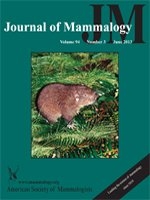Understanding the structure and evolution of ecological communities requires an examination of the factors that influence plant–animal mutualistic interactions. These interactions are affected by factors that are both extrinsic and intrinsic to the animals. We used a meta-analysis technique to examine such factors affecting the interactions between frugivorous animals and the plants they feed upon, using 3 common Neotropical frugivorous bat genera (Carollia, Sturnira, and Artibeus) as a model. We assessed whether latitude, altitude, ecoregion, and bat body size were related to the proportions of the most important plant genera in the diet of the bats. Our results show that extrinsic factors did not affect the proportion of Piper in the diet of Carollia. The proportion of Solanum in the diet of Sturnira was positively correlated with latitude and decreased in the mountain, moist, and bahia interior ecoregions. The proportion of Ficus and Cecropia in the diet of Artibeus decreased in high-elevation ecoregions and was negatively correlated with altitude. The large Artibeus species featured more Ficus and Cecropia in their diets compared to the small species of this genus. Our work demonstrates that mutualistic interaction between Neotropical bats and their core plant taxa is mediated by geographic and morphological factors.
Entender la estructura y evolución de las comunidades ecológicas requiere de la evaluación de los factores que influyen en las interacciones mutualistas entre plantas y animales. Estas interacciones son afectadas por factores extrínsecos e intrínsecos a los animales. Usamos técnicas meta-análiticas para evaluar los factores que afectan las interacciones entre animales frugívoros y las plantas que consumen, usando 3 de los géneros más comunes de murciélagos frugívoros Neotropicales (Carollia, Sturnira y Artibeus) como modelos. Evaluamos si la latitud, altitud, ecoregion y tamaño corporal estaban relacionados con la proporción de los géneros de plantas más importantes en la dieta de estos murciélagos. Nuestros resultados muestran que factores extrínsecos no intervienen en la proporción de Piper en la dieta de Carollia. La proporción de Solanum en la dieta de Sturnira se correlaciona positivamente con la latitud, y es menor en las ecoregiones húmedas, montañosas y bahía. La proporción de Ficus y Cecropia en la dieta de Artibeus disminuyó en las ecoregiones de mayor altitud y se correlacionó negativamente con la altitud. Las especies grandes de Artibeus incluyeron más Ficus y Cecropia en su dieta en comparación con las especies pequeñas de ese género. Nuestro trabajo demuestra que las relaciones mutualistas entre murciélagos Neotropicales y las plantas que comprenden el núcleo de su dieta es mediado por factores geográficos y morfológicos.





